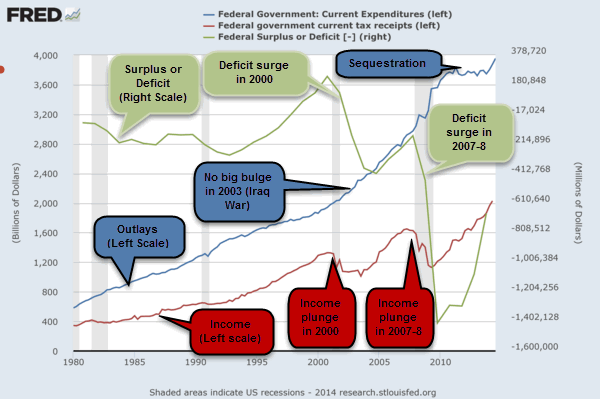This morning’s key headlines from GenerationalDynamics.com
- End of sequestration signals explosive new spending splurge in Washington
- The Iraq war had nothing to do with the federal deficit
- Government receipts plunged when the bubbles burst
- The high federal deficit is caused by bubbles bursting, not the Iraq war
End of sequestration signals explosive new spending splurge in Washington
Japan and Europe are planning enormous quantitative easing programs, and the new radical far-left government in Greece is demanding that many of its debts be erased so that it can go on a new spending binge.
America’s experiment with “sequestration” was truly mind-boggling. President Obama proposed it as a stunt, thinking that Republicans would never agree to let it be applied to defense spending, and then when the Republicans signed on, we could all enjoy a few rounds of Schadenfreude watching Obama try to squirm out of it.
What was mind-boggling about it is that it did cap spending in Washington for a while, something akin to pigs flying, and something that could only have happened by accident — in this case the unexpected outcome of Obama’s stunt.
But now many Republicans are pointing to unrest in the Mideast and the militaristic rise of China with concerns for the defense budget, while Obama would like to join Greece in going on a new spending binge.
A major part of that spending binge is on Obamacare, which is a financial disaster but is being held together with duct tape and astronomical subsidies. In 2014, 87% of federal Obamacare enrollees got subsidies. For the silver plan, out of an annual $4,140 premium, the subsidy amounts to $3,132, leaving the patient only $828 to pay out of the $4,140. And even with that, a typical deductible is $5,000-15,000, which means that most of these insured are effectively uninsured, since they’ll have to pay all their own medical expenses anyway. So there may be more “effectively uninsured” people today than there were uninsured people in the past.
Then there’s CNBC, where the analysts lie constantly about stock valuations. I used to quote analysts doing this, hoping to name and shame them. (See, for example, “14-Apr-12 World View — Wharton School’s Jeremy Siegel is lying about stock valuations” from 2012.) But now criminal fraud is so entrenched in the culture that no one has any shame. And they are just taking after the Obama administration that brings criminal investigations against reporters they don’t like and uses the IRS to attack political opponents with a level of criminality that goes far beyond what Richard Nixon ever dreamed of or was threatened with impeachment for. Congress is just as bad, with massive insider trading and fraud conducted by both parties and both branches of Congress, as exposed by former Breitbart editor Peter Schweizer, covered at length on the CBS show 60 Minutes.
By the way, according to Friday’s Wall Street Journal, the S&P 500 Price/Earnings index (stock valuations index) on Friday morning (January 31) is still at an astronomically high 19.79. This is far above the historical average of 14, indicating that the stock market is in a huge bubble that could burst at any time. Generational Dynamics predicts that the P/E ratio will fall to the 5-6 range or lower, which is where it was as recently as 1982, resulting in a Dow Jones Industrial Average of 3000 or lower.
With sequestration likely to be thrown out, and a new spending binge approved in Washington and around the world, this is a good time to go over some interesting facts about the federal deficit. AP and Guardian (London)
The Iraq war had nothing to do with the federal deficit

Federal income, outlays and deficit, 1980 to present (as of November)
We’re going to look at the above graph, step by step, to show where the federal budget deficit comes from.
Almost everybody believes that the large federal budget deficit was caused by the 2003 invasion of Iraq. Nothing could be farther from the truth. In fact, since the deficit began in the year 2000, so the Iraq war couldn’t have caused it.
So start by looking at the above graph. To begin, focus on the blue line – government expenditures:
- Government spending was $600 billion in 1980, and $3.9 trillion in 2014.
- Notice that there is NO BULGE in 2003 at the start of the Iraq war. Spending increased at the previous rate. That’s because there was no draft, and no new troops were recruited. Troops working on other projects were reassigned to Iraq, so there was no increase in expenditures.
- Notice that the blue line levels off in 2011. That’s because of sequestration. That’s the only time that government spending was not increasing rapidly.
Government receipts plunged when the bubbles burst
Next, in the above graph, focus on the red line – government income / tax receipts:
- Tax receipts were $340 billion in 1980, and $1.8 trillion in 2014.
- Tax receipts plunged in 2000, because of the tech crash in the stock market. They start to recover in 2004, thanks to the real estate and credit bubbles. Then they plummet sharply again in 2008, as the real estate bubble collapses. Tax receipts rise again in 2010, because of quantitative easing and the new stock market bubble.
The high federal deficit is caused by bubbles bursting, not the Iraq war
Finally, in the above graph, focus on the green line – government surplus or deficit (surplus increase upward, deficit increases downward):
- Federal surplus = income – outlays. Deficit = outlays – income.
- The deficit has not been affected by outlays or government spending, even by spending on the Iraq war.
- The deficit went down when income went up, and vice versa. The deficit depends entirely on tax collections, and tax collections have depended on the real estate and stock market bubbles.
So the government surplus at the end of the 1990s was caused by the tech bubble. The government deficit in the early 2000s was caused by the crash of the tech bubble. The reduced deficit in the mid-2000s decade was caused by the real estate bubble. The deficit increased when the real estate bubble crashed. Now the deficit is coming down because of the new stock market bubble.
As I wrote above, the S&P 500 Price/Earnings ratio is at astronomically high levels. It will fall to about 5-6 or lower at some point, and the stock market index will fall by 75% or more.
At that point, the deficit will soar to unsustainable levels, and all these new spending programs will have to be canceled, except those on which the survival of the country depend.
KEYS: Generational Dynamics, Japan, Europe, Greece, sequestration, IRS, Obamacare, CNBC, stock valuations, Richard Nixon, Peter Schweizer
Permanent web link to this article
Receive daily World View columns by e-mail

COMMENTS
Please let us know if you're having issues with commenting.